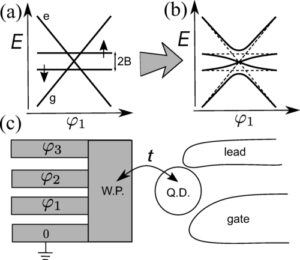Y. Chen and Y. V. Nazarov
Phys. Rev. B 103, 045410 – Published 12 January 2021 (Editors’ Suggestion)
ABSTRACT: We propose a four-state quantum system, or quantum unit, that can be realized in superconducting heterostructures. The unit combines the states of a spin and an Andreev qubit providing the opportunity of quantum superpositions of their states. This functionality is achieved by tunnel coupling between a four-terminal superconducting heterostructure housing a Weyl point and a quantum dot. The quantum states in the vicinity of the Weyl point are extremely sensitive to small changes of superconducting phase; this gives rich opportunities for quantum manipulation. We establish an effective Hamiltonian for the setup and describe the peculiarities of the resulting spectrum. We concentrate on the four-state subspace and explain how to make a double qubit in this setup. We review various ways to achieve quantum manipulation in the unit: this includes resonant, adiabatic, diabatic manipulation and combinations of those. We provide detailed illustrations of designing arbitrary quantum gates in the unit.
We propose a four-state quantum system, or quantum unit, that can be realized in superconducting heterostructures. The unit combines the states of a spin and an Andreev qubit providing the opportunity of quantum superpositions of their states. This functionality is achieved by tunnel coupling between a four-terminal superconducting heterostructure housing a Weyl point and a quantum dot. The quantum states in the vicinity of the Weyl point are extremely sensitive to small changes of superconducting phase; this gives rich opportunities for quantum manipulation. We establish an effective Hamiltonian for the setup and describe the peculiarities of the resulting spectrum. We concentrate on the four-state subspace and explain how to make a double qubit in this setup. We review various ways to achieve quantum manipulation in the unit: this includes resonant, adiabatic, diabatic manipulation and combinations of those. We provide detailed illustrations of designing arbitrary quantum gates in the unit.
